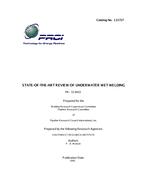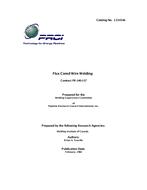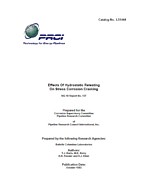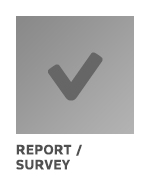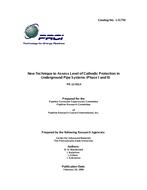Provide PDF Format
PRCI PR-15-9433
- State-of-the-Art Review of Underwater Wet Welding
- Report / Survey by Pipeline Research Council International, 02/01/1995
- Publisher: PRCI
$25.00$49.00
L51727e
Southwest Research Institute
Need: Offshore pipelines and platforms or other submerged on-shore pipelines are subject to in-service damage which often requires in-situ (underwater) repair. In addition, modifications or additions to these underwater systems are sometimes desirable. These operations, particularly repair, are normally on a critical path to return the systems to full operation. Wet welding is a very attractive technique for such operations in that it is more cost effective, versatile, less time consuming than applications of dry hyperbaric or one-atmosphere welding systems. In fact, this technique has been used for numerous repair operations. These operations involved a wide range of materials and structures and have produced satisfactory results. There have been a number of problems identified with wet welds and because of these problems, operators of oil and gas pipelines and offshore platform owners/users have not been able to fully exploit the advantages of wet welding.
Benefit: In order to more clearly define the present state-of-the-art, a literature search and an industry survey has been conducted to gather pertinent information on wet welding. Of particular interest was the feasibility of performing pipeline repairs or modifications that might require open root techniques for one-sided pipe welds. Also of interest was the impact of increasing water depth on the defect level of the resultant weld, including porosity and the subsequent leak integrity of the joint. The relevant data was then organized into general categories of information on the specific topics of wet welding and analyzed to produce this report.
Result: The following conclusions are drawn based upon the information received and analysis of that information: There was no technical wet welding data generated with regard to open root welding of either plate or pipe in the literature reviewed. All butt welding has been performed utilizing a backing bar or double sided welding. Only one industry contact reported any experience with open roots. They reported that they had limited success on plate at a 15° angle (from horizontal) but were unable to weld pipe. No testing data or specifics were offered. This report fully describes the present difficulties with porosity and welding depth, i.e., increasing depth of welding causes increasing porosity. The level of porosity varies from low, i.e., 1 to 2% at shallow depths to 10 to 15% at greater depths. Newly developed SMAW electrodes might reduce the porosity level but will unlikely consistently meet API-1104 requirements for the deeper welding depths. Other welding flaws such as slag, inadequate penetration, incomplete fusion, and undercut are controllable to D 3.6 Type B or Type A requirements given suitable electrodes, welder skill, and welding conditions. There is an inherent increase in potential for welding flaws with increasing water depths. This is believed to be associated with increasing arc instability as well as poorer visibility and diver/welder discomfort. Cracking in either the HAZ or weld metal are more dependent on the alloys involved, joint designs, and restraint stresses than on procedures or welding skill. Consumables and procedures exist that routinely produce suitable welds in materials with a CE of 0.40% or less and some at higher CE's. The wet weldments can display satisfactory tensile strength, fracture toughness, and fatigue resistance but suffer a loss of ductility and lower upper shelf notch toughness, particularly with increasing depth. Wet welds in combination with innovative designs can (in many instances) be considered fit-for-service in a wide range of structural and piping systems applications.
Southwest Research Institute
Need: Offshore pipelines and platforms or other submerged on-shore pipelines are subject to in-service damage which often requires in-situ (underwater) repair. In addition, modifications or additions to these underwater systems are sometimes desirable. These operations, particularly repair, are normally on a critical path to return the systems to full operation. Wet welding is a very attractive technique for such operations in that it is more cost effective, versatile, less time consuming than applications of dry hyperbaric or one-atmosphere welding systems. In fact, this technique has been used for numerous repair operations. These operations involved a wide range of materials and structures and have produced satisfactory results. There have been a number of problems identified with wet welds and because of these problems, operators of oil and gas pipelines and offshore platform owners/users have not been able to fully exploit the advantages of wet welding.
Benefit: In order to more clearly define the present state-of-the-art, a literature search and an industry survey has been conducted to gather pertinent information on wet welding. Of particular interest was the feasibility of performing pipeline repairs or modifications that might require open root techniques for one-sided pipe welds. Also of interest was the impact of increasing water depth on the defect level of the resultant weld, including porosity and the subsequent leak integrity of the joint. The relevant data was then organized into general categories of information on the specific topics of wet welding and analyzed to produce this report.
Result: The following conclusions are drawn based upon the information received and analysis of that information: There was no technical wet welding data generated with regard to open root welding of either plate or pipe in the literature reviewed. All butt welding has been performed utilizing a backing bar or double sided welding. Only one industry contact reported any experience with open roots. They reported that they had limited success on plate at a 15° angle (from horizontal) but were unable to weld pipe. No testing data or specifics were offered. This report fully describes the present difficulties with porosity and welding depth, i.e., increasing depth of welding causes increasing porosity. The level of porosity varies from low, i.e., 1 to 2% at shallow depths to 10 to 15% at greater depths. Newly developed SMAW electrodes might reduce the porosity level but will unlikely consistently meet API-1104 requirements for the deeper welding depths. Other welding flaws such as slag, inadequate penetration, incomplete fusion, and undercut are controllable to D 3.6 Type B or Type A requirements given suitable electrodes, welder skill, and welding conditions. There is an inherent increase in potential for welding flaws with increasing water depths. This is believed to be associated with increasing arc instability as well as poorer visibility and diver/welder discomfort. Cracking in either the HAZ or weld metal are more dependent on the alloys involved, joint designs, and restraint stresses than on procedures or welding skill. Consumables and procedures exist that routinely produce suitable welds in materials with a CE of 0.40% or less and some at higher CE's. The wet weldments can display satisfactory tensile strength, fracture toughness, and fatigue resistance but suffer a loss of ductility and lower upper shelf notch toughness, particularly with increasing depth. Wet welds in combination with innovative designs can (in many instances) be considered fit-for-service in a wide range of structural and piping systems applications.
Related Products
PRCI PR-328-063502
INVESTIGATIVE FUNDAMENTALS AND PERFOMANCE IMPROVEMENTS OF CURRENT IN-LINE INSPECTION TECHNOLOGIES FO..
$6.00 $12.00
PRCI PR-12-9314
New Technique to Assess Level of Cathodic Protection in Underground Pipe Systems..
$125.00 $249.00

